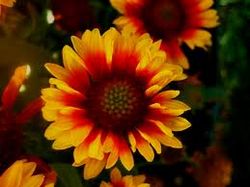Gaillardia aristata
- Latin Name: Gaillardia aristata
- Family: Asteraceae
- Common Names: blanket flower, great flowered gaillardia
- Codon: GALARI
Contents
Taxonomy
Description
General: Perennial from a slender taproot, usually with several simple, hairy stems from the base, 2-7 dm. tall.
Leaves: Leaves narrow, linear-oblong to lance-ovate, up to 15 cm. long and 2.5 cm. wide, entire to coarsely toothed.
Flowers: Heads solitary or few, on long peduncles, the disk 1.5-3 cm. wide, purple or brownish-purple; involucral bracts pointed, loosely hairy; rays usually 13, 1-3.5 cm. long, yellow but purplish at the base; disk corollas with dense woolly hairs toward the tip, which tend to obscure to pointed lobes; receptacle covered with chaffy bristles that are longer than the achenes; pappus of 6-10 awned scales.
Bloom Period
May - September
Distribution
Uncommon east of the Cascades from British Columbia to Oregon
Habitat
Dry, open areas at low to mid-elevations Medium to coarse, well-drained, infertile soil
5.5-7.9 pH, low salinity tolerance Medium water use – medium drought tolerance Shade intolerant Early
Uses
Pollinator food source Attracts butterflies, low palatability for browsing and grazing animals
Used for numerous purposes ranging from soothing the sore nipples of nursing mothers (an infusion of whole plant applied topically) to curing cancer (an infusion of the whole plant is drunk). Warning: The plants fuzzy hairs can cause a skin irritation in some susceptible people.
Propagation
Propagated by seed, root division or separation of offsets. Plant untreated seed in spring or fall. Germination is extremely variable. Plants may flower by the end of the first season. Make root divisions in early spring, dividing the tap root vertically

